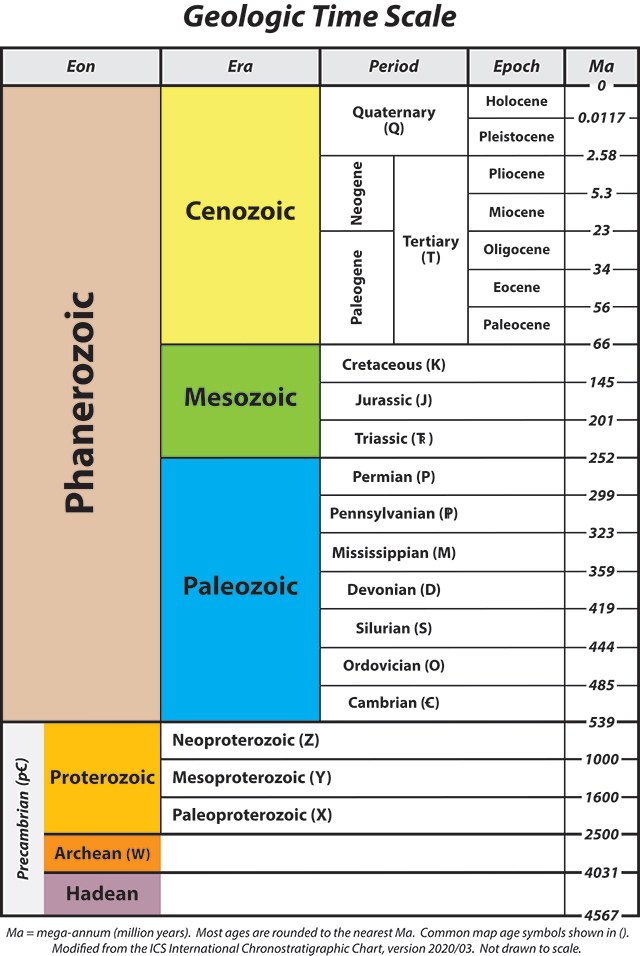Part C
Geologic Time
Earth's history is spread over a vast amount of time. To begin to understand that history, we need some kind of calendar or time scale. Earth's history is thought to span about 4.6 billion years. This amount of time is almost (maybe totally) incomprehensible to most humans, given that our life histories are measured in days, months, and years. There are many graphical ways to represent geologic time, and some simplified geologic time scales are shown in Figures 3-6a and 3-6b.
|
|
|
Figure 3-6a. A simplified geologic time scale for Earth's entire history (about 4 1/2 billion years). |
|
|
|
Figure 3-6b. A simplified geologic time scale for the latest portion (the Phanerozoic Eon - the last 1/2 billion years or so) of Earth's history. |
The geologic time scale has evolved into its present form over the past century or so, essentially since the discovery of radioactivity and its application to dating rocks. During this time, rock units from all around the world have been correlated and their dates refined. The current time scale and its dates are defined by the International Commission on Stratigraphy (ICS), part of the International Union of Geological Sciences (IUGS). The International Chronostratigraphic Chart v.2020/03 is the one referenced in this course.
Earth history's timeline's of roughly 4.6 billion years is broken down into progressively smaller and smaller units (i.e., Eons, Eras, Periods, Epochs):
Eons - There are four eons: Hadean, Archean, Proterozoic, and Phanerozoic. Most of the geology you'll ever see is of Phanerozoic age. The oldest rocks in Arizona are Proterozoic in age. The Archean and Hadean eons are the two oldest eons, with remnants of some rocks dated to 4.4 billion years old. The term "Precambrian" is often used to describe rocks with ages older than the Phanerozoic Eon. We currently live in the Phanerozoic Eon.
Eras - Each eon can be divided into smaller eras. For example, eras in Proterozoic Eon include the Paleoproterozoic, Mesoproterozoic, and Neoproterozoic. The Phanerozoic Eon has three eras: the Paleozoic ("old life"), Mesozoic ("middle life"), and Cenozoic ("new life"). We currently live in the Cenozoic Era.
Periods - Eras can be broken into smaller periods. At the introductory level in Geology, we typically don't bother with the periods in the Proterozoic. However, the periods of the Phanerozoic eras are commonly used. The Paleozoic Era has seven periods (Cambrian to Permian), the Mesozoic Era has three (Triassic, Jurassic, and Cretaceous), and the Cenozoic Era currently has three (Paleogene, Neogene, and Quaternary). We currently live in the Quaternary Period.
Epochs - Each period can be split into smaller Epochs. These are the smallest time divisions that are typically used at the Introductory Geology level. You've probably heard the term "Pleistocene" before in relation to the last global ice age. When dealing with relatively young rock ages, we commonly refer to the seven epochs of the Cenozoic Era. We currently live in the Holocene Epoch.
The standard time scale is constantly being refined with the discovery of new rocks and use of improved dating techniques. Figure 3-7 incorporates more recent data (from the 2020 version) and is the one you will use for this class.
|
Figure 3-7. A simplified geologic time scale that we'll use for this class. Click HERE for a printable PDF version. * IMPORTANT * |
A few observations about the time scale in Figure 3-7:
> This time scale is not drawn to scale, so the size of the time blocks are not proportional with their lengths relative to each other.
> The letters / symbols in parentheses next to some of the periods and eras are map symbols that are typically used on geologic maps. For example, a Neoproterozoic rock unit would have a map symbol beginning with "Z" (like Zc, the Neoproterozoic Chuar Group).
> Geologic time is commonly given in billions of years (giga-annum = Ga), millions of years (mega-annum = Ma), and thousands of years (kilo-annum = Ka). For example, some of the Cardenas Lavas in the Grand Canyon have been dated at 1,103 million years old, which can be represented as 1103 Ma or about 1.1 Ga. Additionally, Elden Mountain in Flagstaff, Arizona erupted about 550 thousand years ago, which can be written as 0.55 Ma, 550 Ka, or 550,000 a.
> You may have noticed that some of the boundary ages are different between Figure 3-7 and the preceding Figure 3-6. This is because the timeline is constantly being refined with the discovery of new rocks and use of improved dating techniques. Figure 3-7 incorporates more recent data and will be the one you will use for this class.
.
|
Example 6 |
|
True or false: the Paleozoic is the longest of the three Phanerozoic eras? |
|
True The Paleozoic spans from 541 Ma to 252 Ma, a total of 289 Ma (longer than the Mesozoic and the Cenozoic combined) |
|
Example 7 |
|
What is the second youngest Paleozoic period? Note: younger = newer = more recent = less years. |
|
Pennsylvanian |
Questions C31 through C40 refer to the geologic time scale in Figure 3-7.
![]()
![]()
![]()
![]()
![]()
![]()
![]()
![]()
![]()
![]()


